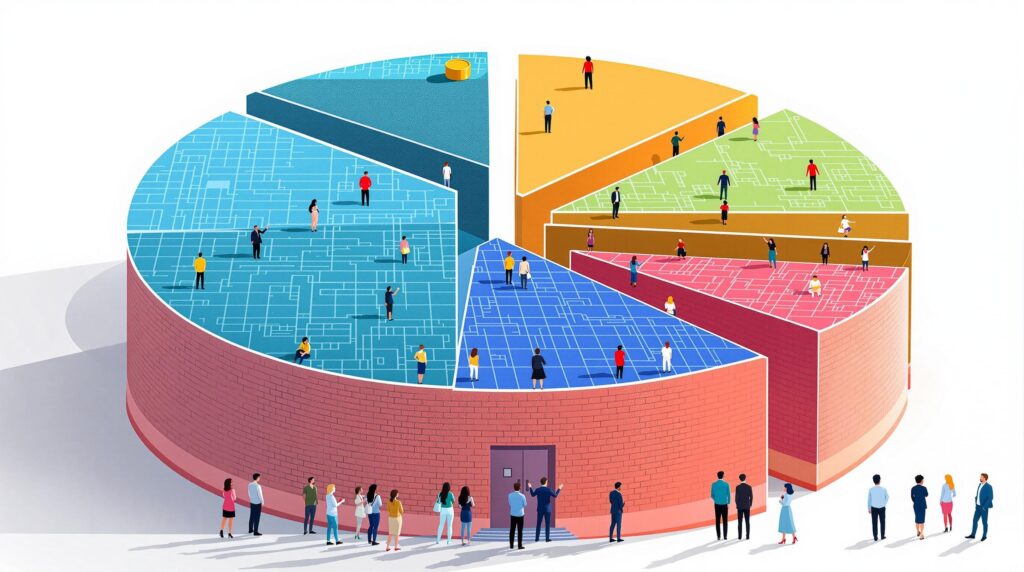[rev_slider alias=”slider-1″][/rev_slider]
Understanding Layer 1 Blockchains
Picture the foundation of a house – strong, stable, and essential for everything that builds upon it. That’s what Layer 1 blockchains are to the innovative world of blockchain technology. They form the primary network architecture that provides the fundamental layer beneath every transaction and smart contract. Some renowned examples you might be familiar with, like Bitcoin and Ethereum, come under this category. But what exactly are the defining features of these Layer 1 blockchains?
Decentralization is perhaps their most celebrated feature. Unlike traditional banking systems where control lies in the hands of central authorities, Layer 1 blockchains distribute control across a network of nodes. This decentralized nature ensures that no single entity can manipulate the network, offering a trustworthy and transparent alternative to conventional systems.
What is Blockchain Decentralization? Blockchain decentralization means distributing control and decision-making processes across a network, negating the influence of a single authoritative body.
Layer 1 blockchains also provide unparalleled security. How is this achieved? Through consensus mechanisms like Proof of Work (PoW) and Proof of Stake (PoS). These mechanisms are designed to confirm the authenticity of transactions and maintain the integrity of the distributed ledger. By doing so, they safeguard the blockchain from potential attacks and unauthorized alterations.
A pivotal aspect of Layer 1 blockchains is their ability to facilitate transactions and smart contracts seamlessly. For instance, think about a decentralized application (dApp) operating on Ethereum. Its operation depends on the reliability and efficiency of Layer 1 blockchains. They enable both everyday transactions and complex smart contracts by processing thousands of data bits efficiently and securely.
Bitcoin, known as the pioneer of cryptocurrency, operates as a Layer 1 blockchain. It introduced the concept of decentralized digital currency, allowing users to send and receive bitcoins without intermediaries. Crimes involving bitcoin have highlighted the need for strong security features inherent to Layer 1 systems, ensuring their continued evolution and resilience.
Ethereum, another key player in Layer 1 technology, supports a wide variety of decentralized applications, thanks to its robust and extendable infrastructure. With its smart contract functionality, Ethereum extends beyond mere currency exchanges, enabling endless possibilities for innovation and application development.
Moreover, Layer 1 blockchains are crucial for scalability—a hot topic in the blockchain world. Despite facing challenges, efforts continuously evolve to address the question: How can Layer 1 blockchains improve scalability? Developers constantly seek to enhance transaction speed and network capacity without compromising the factors that make blockchain technology revolutionary.
Are Layer 1 blockchains necessary for blockchain transactions? Absolutely! They provide the foundational infrastructure necessary for executing secure and transparent transactions across the blockchain ecosystem.
Understanding these core concepts helps in appreciating the pivotal role that Layer 1 blockchains play in the larger blockchain ecosystem. As Africa embarks on its digital asset journey with initiatives like Jara’s proprietary Layer 2 blockchain, the significance of understanding these foundational systems becomes even more crucial. Jara is taking strides in bridging global capital with African assets, opening new avenues for economic growth and financial empowerment through digital assets.
Layer 2 Solutions: An Overview
Layer 2 solutions are like the turbo boost for traditional cryptocurrencies, enhancing the base Layer 1 blockchains by tackling their inherent limitations. But what are these limitations, and how exactly do Layer 2 solutions address them? Let’s delve deeper into the exciting world of Layer 2 technologies.
What are Layer 2 solutions? Layer 2 solutions are technologies that operate on top of layer 1 blockchains to boost scalability, speed up transactions, and reduce fees.
Layer 1 blockchains, such as Bitcoin and Ethereum, are renowned for their security and decentralization. However, as thousands of transactions compete for limited block space, transaction fees soar, and network speed declines. That’s where Layer 2 solutions step in, acting as a scalable, cost-efficient means to improve performance.
Purpose of Layer 2 Solutions
- Scalability Enhancement: By processing transactions off the main blockchain, Layer 2 reduces congestion, allowing the primary network to handle more transactions per second (TPS).
- Transaction Speed Improvement: Transactions on Layer 2 can be processed almost instantly, whereas Layer 1 transactions might take longer due to network traffic.
- Cost Reduction: Users enjoy lower fees because Layer 2 reduces reliance on the Layer 1 blockchain, where transaction costs are higher.
But you might be wondering, how do these solutions actually work? A simple analogy can clarify this. Imagine a toll booth on a highway—when there’s only one booth, the cars line up, leading to long waits. Layer 2 solutions add more booths, redirecting traffic and easing congestion, so everyone gets through faster and at a reduced cost.
Popular Layer 2 Solutions
Let’s explore some of the prominent Layer 2 solutions making waves in the world of blockchain.
| Solution Name | Description | Blockchain |
|---|---|---|
| Lightning Network | An off-chain network that enables fast and cheap Bitcoin transactions by settling them in batches. | Bitcoin |
| Sidechains | Independent blockchains that run parallel to the Ethereum mainnet, allowing tokens to move freely between chains. | Ethereum |
| Plasma | A framework for building scalable applications that operate at an off-chain level before settling on the Ethereum mainnet. | Ethereum |
Africa is poised for digital transformation, and Layer 2 solutions are at the forefront, enabling scalable and efficient blockchain applications vital for the continent’s growth.
For regions like Africa, Layer 2 solutions hold immense potential, particularly in bridging global capital with local assets. By reducing the cost and increasing the speed of transactions, these solutions can facilitate more inclusive financial ecosystems. Cryptocurrency regulation and infrastructure are crucial components that Layer 2 blockchains can bolster.
Moreover, the innovative approach of Jara utilizes a proprietary Layer 2 blockchain to enhance the digital asset ecosystem in Africa. By focusing on scalability and efficiency, Jara aims to empower users with better access to financial tools, thus creating a robust platform for real-world applications.
So, are Layer 2 solutions the magic bullet for blockchain? While they’re not a cure-all, they certainly mark a significant stride towards solving some of the industry’s pressing challenges, making blockchain more accessible for people worldwide, and particularly in burgeoning markets such as Africa.
Investing in Layer 2 solutions like those provided by Jara presents an opportunity to be part of Africa’s digital asset revolution, driving both innovation and investment across the continent.
[rev_slider alias=”text-call-cta”][/rev_slider]
The Need for Both Layers in Blockchain Ecosystem
In the realm of blockchain technology, one might wonder whether both Layer 1 and Layer 2 solutions are truly necessary. To understand their importance, it’s essential to explore how these layers complement each other and enhance the overall functionality and performance of blockchain ecosystems, especially in regions like Africa that are at the forefront of digital transformation.
What is Layer 1? Layer 1 blockchains are the foundational networks that provide the underlying architecture, such as Ethereum or Bitcoin, enabling decentralized operations and transactions.
Layer 1 solutions are the backbone of the blockchain, providing the core framework for peer-to-peer interactions. These networks handle tasks such as consensus mechanisms, transaction processing, and overall security. However, as the popularity of blockchain technologies increases, so do the demands on these Layer 1 networks. This is where the limitations of Layer 1 blockchains become apparent—issues like scalability and high transaction fees can hinder mass adoption.
What is Layer 2? Layer 2 solutions build on top of Layer 1 blockchains to provide enhanced performance features such as increased transaction speeds and lower fees through off-chain processing.
The introduction of Layer 2 solutions aims to alleviate these challenges by offering ways to improve scalability and efficiency without altering the core blockchain. Layer 2 operates by moving transactional operations off-chain while still anchoring security and data integrity to the Layer 1 network. This approach not only boosts speed but also reduces costs, which is critical for encouraging widespread use of blockchain technologies.
Examples of Layer 2 Enhancements
- Transaction Speed: By conducting multiple transactions off-chain and only recording the final state on the Layer 1 chain, Layer 2 solutions can significantly increase transaction throughput.
- Cost Efficiency: With fewer on-chain transactions, users benefit from reduced network fees, making blockchain applications more accessible, particularly in emerging markets like Africa.
In Africa, where financial inclusion is a pivotal focus, such enhancements can create economic opportunities by drastically reducing entry barriers for individuals and businesses. For example, Jara is employing a proprietary Layer 2 blockchain as part of its offering, which is designed to improve transaction efficiency and scalability in the African digital asset ecosystem.
Complementary Roles in the Ecosystem
The synergy between Layer 1 and Layer 2 is pivotal for a robust and versatile blockchain ecosystem. While Layer 1 ensures security and data integrity, Layer 2 diverges into providing practical solutions for scaling and usability, which are vital for applications like instant micropayments and smart contract execution. Together, they create a hybrid approach mirroring the need for both stability and adaptability in the fast-evolving digital landscape.
Why are both layers important? Layer 1 provides the secure and resilient foundation for decentralization, while Layer 2 offers the flexibility and efficiency required for scalable applications, crucial for supporting economic progress in regions like Africa.
Thus, the coexistence of Layer 1 and Layer 2 blockchain solutions is not just a technical necessity—it is an enabler of innovation and growth, providing a pathway for digital inclusion and economic development where it is needed most. As Africa embraces this technological shift, platforms like Jara are at the helm, bridging global capital with African assets through innovative blockchain infrastructure tailored to the continent’s unique needs.
Future Outlook: Evolution of Layer 1 and Layer 2
The blockchain ecosystem is continuously evolving, driven by the quest for efficiency, scalability, and integration between different blockchain layers. Let’s delve into the potential future developments that might shape the interaction between Layer 1 and Layer 2 technologies.
Innovations in Layer 1 and Layer 2 Technologies
In recent years, both Layer 1 and Layer 2 solutions have seen significant technological advancements. However, the journey is far from over. Here are some promising innovations on the horizon:
- Decentralized Finance (DeFi) Enhancements: As DeFi continues to gain traction, Layer 2 solutions are expected to enhance its functionality by reducing transaction costs and increasing throughput, leading to more accessible financial services.
- Cross-Chain Compatibility: The development of cross-chain communication protocols is essential for seamless interaction between various blockchains. This allows Layer 2 solutions to harness the full potential of multiple Layer 1 blockchains.
- Eco-Friendly Protocols: With rising concerns over the environmental impact of blockchain, research is focused on energy-efficient consensus mechanisms for Layer 1 networks, which could see Layer 2 solutions adopting eco-friendly practices as well.
These advancements are not just theoretical; numerous projects are actively exploring and implementing such innovations. Platforms like cryptocurrency defense strategies are adapting to these disruptive changes.
Research Projects and Collaborations
Collaboration appears to be the name of the game in enhancing blockchain integration. Consider ongoing projects that aim to unify these layers:
- Enterprise Integration: Major corporations are collaborating with blockchain firms to leverage Layer 2 solutions for enterprise applications, enabling smoother, faster, and cost-effective operations.
- Academic Research: Universities and research institutions are at the forefront of pushing the capabilities of blockchain. They explore the implementation of new cryptographic algorithms and scaling solutions that could redefine Layer 1 and Layer 2 interactions.
- Partnerships for Innovation: Many Layer 1 blockchains are seeking partnerships with Layer 2 projects to achieve specific goals, such as reducing latency and optimizing resource distribution.
Potential Impact on the Cryptocurrency Market
With these advancements, what does the future hold for the cryptocurrency market and blockchain adoption?
The integration of Layer 1 and Layer 2 technologies promises enhanced scalability, security, and accessibility. This marriage may yield more robust platforms capable of supporting mainstream adoption.
With increased efficiency and lower costs, blockchain technology may finally overcome previous barriers, allowing widespread adoption and acceptance.
Moreover, Jara, spearheading blockchain innovations in Africa, stands out as a vital player. They leverage Layer 2 solutions not just for financial services optimization but also for transforming traditional infrastructure, such as the Lagos airport project, into tokenized assets.
The Jara Ecosystem exemplifies how Layer 2 technology transitions into real-world use cases, presenting a rich tapestry of opportunities for investment and application across the African continent.
Speculative Outcomes and Future Trends
While exact forecasts remain speculative, trends indicate a promising future:
- Mass Adoption: As interoperability improves, more businesses and individuals may engage with blockchain-based solutions for daily transactions and investments.
- Increased Institutional Interest: Financial giants are more likely to invest in Layer 2 solutions that promise higher efficiency and lower transaction costs.
- Global Expansion: With the support of technologies like Jara’s infrastructure, Layer 1 and Layer 2 can expand their reach, offering financial tools to previously underserved regions, notably Africa.
The future is looking bright for Layer 1 and Layer 2 blockchains, and with Jara leading the charge in Africa, this region could be a significant hub for digital property and blockchain innovations.
By integrating the information about Jara and associated advancements, the content remains relevant and informative while maintaining a focus on the future of Layer 1 and Layer 2 technologies.
[rev_slider alias=”schedule-consultation-btn”][/rev_slider]

What is the main difference between Layer 1 and Layer 2 blockchains?
Layer 1 blockchains refer to the base layer of the blockchain protocol, focusing on decentralization, security, and consensus mechanisms. Layer 2 blockchains, on the other hand, are built on top of Layer 1 to enhance scalability and transaction speed without altering the original blockchain layer.
Layer 1 blockchains are primarily concerned with the core functions of a blockchain like maintaining consensus, security, and permanence through technologies such as Proof of Work or Proof of Stake. Layer 2 solutions such as sidechains or the Lightning Network are designed to address limitations in Layer 1, improving efficiency by processing transactions off-chain or parallel to the main blockchain.
How do Layer 2 solutions improve blockchain scalability?
Layer 2 solutions enhance blockchain scalability by allowing multiple transactions to occur off-chain with minimal interaction with the Layer 1 chain, thereby increasing the number of transactions processed simultaneously.
Layer 2 solutions create a secondary protocol that operates on top of existing blockchains, handling transactions separately and compressing them into a single transaction when finalizing on the core blockchain. This allows for faster confirmation times and reduced congestion on the Layer 1 blockchain.
Are there security trade-offs when using Layer 2 solutions?
Layer 2 solutions can present security trade-offs as they rely on different consensus mechanisms and off-chain networks which may not be as robust as Layer 1’s secure environment.
While Layer 2 solutions greatly boost efficiency and speed, they may not inherently possess the same level of security as the base Layer 1 blockchain. However, continuous developments are being made to enhance their robustness and integrate sophisticated security measures.
Why is the adoption of both Layer 1 and Layer 2 necessary in blockchain technology?
The adoption of both Layer 1 and Layer 2 technologies is crucial because it allows blockchains to maintain their core security and decentralization while scaling effectively and improving user experiences.
The interplay between Layer 1 and Layer 2 provides a comprehensive framework where Layer 1 ensures decentralized security, while Layer 2 handles the demands of speed and scalability required for widespread blockchain adoption. This balance is necessary for supporting complex applications and a growing user base without compromising blockchain integrity.

Related Pages
Explore additional pages that enhance your understanding of blockchain technology, featuring insights and solutions.
Discover What Our Clients Are Saying
At the forefront of our blockchain solutions practice is a deep-seated commitment to client satisfaction. Each case is handled with utmost care, as echoed in the appreciative feedback from those we represent.

[rev_slider alias=”slider-3″][/rev_slider]
[rev_slider alias=”slider-6″][/rev_slider]
Unlock the Full Potential of Blockchain Solutions with Jara
Are you ready to navigate the complexities of Layer 1 and Layer 2 blockchain solutions? Discover how Jara can connect you to groundbreaking opportunities within the blockchain landscape. Let us guide you in harnessing the power of both layers to optimize your blockchain initiatives.
“Your Gateway to Blockchain Evolution” – At Jara, we specialize in blending advanced blockchain solutions with seamless user experience, ensuring your projects remain at the forefront of innovation.
But don’t just take our word for it. Explore why Jara stands out in the world of blockchain consulting:
- Recognized Among the “Top Blockchain Consulting Firms” in Nairobi 2023 by Expertise.com – Celebrating our dedication to innovative blockchain solutions.
Read More - Listed as a Leading Provider of “Layer 1 and Layer 2 Solutions” 2023 by FinTech Awards – Acknowledging our role in driving scalability and efficiency.
Discover Why - Featured in the “Best Blockchain Firms” Worldwide for 2023 by Global Blockchain Alliance – Highlighting our global impact.
See Our Achievements - Named as one of the “Innovative Blockchain Developers” 2023 by Tech Innovators Network – Recognizing our commitment to advancing blockchain technology.
Learn More - Highlighted for “Outstanding Blockchain Solutions” 2023 by Industry Leaders Magazine – Demonstrating our excellence in delivering cutting-edge blockchain services.
Find Out How
Take the next step towards a successful blockchain future. Contact us today or download the Jara app for Android or iPhone to start your journey.
Chinyere “Chi” Nnadi Bio
Founder and CEO, Jara | Specialist in Blockchain Technology and Digital Assets
Content Reviewed by Chi Nnadi and his Content Team. Chi is an experienced entrepreneur dedicated to transforming Africa’s financial ecosystem through blockchain technology. As Founder and CEO of Jara, he builds enterprise-grade infrastructure converting illiquid African assets into globally accessible digital tokens. With his proprietary Layer-2 blockchain technology, Chi bridges the gap between global investors and Africa’s growing digital asset market.
Our Content Review Process
Chi Nnadi along with Jara’s dedicated content team, pledge to offer top-notch material. Our content guidelines ensure thoroughness, reputable sources, unbiased scrutiny, among other quality metrics. Please let us know if there is anything you believe to be inaccurate.
















